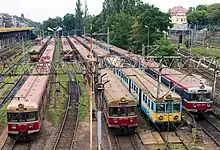PKP class EN57
EN57 is an electric multiple unit used by the Polish railway operator (PKP). It was built for suburban and long-distance services. Presently it is used by Przewozy Regionalne (POLREGIO), Szybka Kolej Miejska and Koleje Mazowieckie companies. Out of over 1400 units produced, about 300 still remain in service in Poland, most of them with Przewozy Regionalne.
| PKP EN57 | |
|---|---|
%252C_Grodzisk_Mazowiecki%252C_2017-01-19_(cropped).jpg.webp) EN57-1703 at Grodzisk Mazowiecki in the new Koleje Dolnośląskie livery | |
| In service | 1962– (Poland) 1964–1991 (Yugoslavia) 1991–2009 (Croatia) 1991– (Slovenia) |
| Manufacturer | Pafawag |
| Constructed | 1961–1993 |
| Number built | 1412 |
| Operator(s) | PKP, PR, KM, SKM, KS, Yugoslav Railways, Hrvatske Željeznice, Slovenske železnice |
| Specifications | |
| Train length | 64,970 m (213,156 ft 2 in) |
| Maximum speed | 110 km/h (68 mph) |
| Weight | 123 tonnes (121 long tons; 136 short tons) |
| Power output | 608 kW (815 hp) |
| Transmission | LK450 |
| Electric system(s) | 3000 V DC Overhead lines |
| Current collection method | Pantograph |
| UIC classification | 2'2'+Bo'Bo'+2'2' |
| Braking system(s) | Knorr Oerlikon (later versions) |
| Track gauge | 1,435 mm (4 ft 8 1⁄2 in) standard gauge |
History

Designed for regional transport class EN57 was based on the earlier class EW55 units. EW55 were the first electrical multiple units built in Poland with 100% of domestic components. They were built by Pafawag works in Wrocław.
Production started in 1962 and ended in 1993 with 1412 units produced, most of which are still in operation. This class is believed to have had the longest production period in the world for electric multiple units. The first units had first-class compartments, but units numbered 602 and upwards were produced with only second class. Due to very long production period, the series varies between specific production spans. Units up to number 1113 have corrugated sides and three windscreens, units numbered 1114 to 1825 have flat sides and three windscreens, whilst units from number 1900 up to 1953 have flat sides and two windscreens, resembling class EW58 units.
As the result of several fires and accidents, units numbered 201 to 206 are assembled from surviving cars of previously destroyed units. Since 2006, Przewozy Regionalne have modernized several units with funding from the European Union. The changes affect the appearance of the units, with the ends being redesigned. The interior was also changed. Mechanical and electric devices remain mostly unchanged. Modified units are being renumbered from 2001 upwards.
Classes EN71, ED72, and ED73 units were based on class EN57. Szybka Kolej Miejska which operates service in the Tricity area uses these units and has also modernized them, this being mostly to the interior.
Technical data
EN57 is a three-car electric multiple unit with traction motors located in the middle car. The unit has four LK450 motors, each with power of 145 kW. The outer two cars are both driving trailers and do not have motors. Trailers are distinguished with letters a and b, with part a including compressor and part b including the batteries.
Each part of the unit consists of three compartments, divided by corridors. In the trailers only two compartments are for passenger accommodation, while the third was thought to be luggage compartment. In the motor car, all three compartments are used by passengers. Previously, there were toilets in all parts of the unit, yet due to several fires caused by neighbouring electric devices, the toilets in the motor cars were removed. Class EN57 is capable of multiple unit operation with two or three units, using Scharfenberger couplers to connect units together. Each unit can seat up to 212 passengers.
Service in other countries
Three units of class EN57 EMU were exported to Yugoslavia in 1964, where they classified 311-0 (for trailers) and 315-0 (for motor cars). Another eleven were subsequently rebuilt from class 315-1 with additional trailers. As in the time of delivery Władysław Gomułka was the leader of Polish Polish United Workers' Party, those items were nicknamed after him.
Modernizations

SPOT and EN57-20XX
In 2006, ZNTK "Mińsk Mazowiecki", Pesa Bydgoszcz and Newag Nowy Sącz begin modernizing 75 EN57 EMUs, financed by European Union funds. The appearance of the end walls, cab driver and interior was changed. The separate service compartments were removed by connecting them with entrance hallways. The modernized EMU was adapted to the needs of disabled people through the installation of elevators for wheelchairs and bigger toilets. EMUs after modernisation had also installed alarm and 16 cameras. The main spinning transformer was replaced by electronic transformer giving voltage 110 V DC, 230 V AC and 24 V DC.
EN57KM
In 2007 SKM Tricity and Koleje Mazowieckie decided to apply the start pulse in some of their EN57's: SKM Trójmiasto: EN57-768, EN57-1089, EN57-1094 i EN57-1116 Koleje Mazowieckie: EN57-1486, EN57-1566, EN57-1567 i EN57-1562 ZNTK "Mińsk Mazowiecki" works made this modernisations. They too applied microprocessor controlled drive and electrodynamic braking.
.jpg.webp)
See also
- Polish locomotives designation
- Szybka Kolej Miejska
- 14WE A heavily modified version of EN57, developed in mid-2000s
Resource
- Polish electric multiple units technical data, URL accessed on June 8, 2007
- EN57 unofficial website, URL accessed on June 8, 2007
- ^ Mundkowa Galeria Kolejowa, retrieved on June 26, 2007.
| Wikimedia Commons has media related to EN57. |
.JPG.webp)